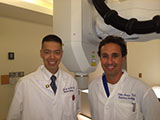


Posted November 12, 2013
Peter Maxim, Ph.D., Billy Loo, M.D., Ph.D., Stanford University, Stanford, California
 Results from the recent National Lung Screening Trial (NLST) demonstrated a 20% reduction in lung cancer deaths in patients screened by low-dose helical computed tomography (CT) when compared to plain chest radiography, cementing the importance of CT-based early detection in decreasing lung cancer-related mortality. Although CT screening is a crucial tool in the early detection of lung cancer, its specificity is far from ideal (e.g., there was a 96.4% false positive rate in the NLST study). The high rate of false positives often leads to increased psychological and economical burden for the patients that undergo unnecessary followup CT screens, invasive surgical procedures, and perhaps most importantly, potential delay in diagnosis and treatment.
Results from the recent National Lung Screening Trial (NLST) demonstrated a 20% reduction in lung cancer deaths in patients screened by low-dose helical computed tomography (CT) when compared to plain chest radiography, cementing the importance of CT-based early detection in decreasing lung cancer-related mortality. Although CT screening is a crucial tool in the early detection of lung cancer, its specificity is far from ideal (e.g., there was a 96.4% false positive rate in the NLST study). The high rate of false positives often leads to increased psychological and economical burden for the patients that undergo unnecessary followup CT screens, invasive surgical procedures, and perhaps most importantly, potential delay in diagnosis and treatment.
In fiscal year 2011, Drs. Maxim and Loo of Stanford University were awarded an LCRP Early Investigator Synergistic Idea Award, an award mechanism intended to support collaborations between laboratory scientists and clinicians to address innovative, high-impact research questions from synergistic and complementary perspectives. Dr. Maxim, a laboratory scientist, and Dr. Loo, a lung cancer clinician, hypothesize that malignant and benign pulmonary nodules have differences in elasticity that may be measured from four-dimensional computed tomography (4D CT) images. 4D CT images are unique in that they incorporate the changes of the anatomy over time in addition to information that can be gained via conventional 3D CT imaging (e.g., presence of a nodule, size, morphology) - in other words, the stiffness of pulmonary nodules may be calculated based on their motion caused by breathing. Based on literature indicating that most solid tumors have increased interstitial fluid pressure that alters the tumor mechanical properties including elasticity, the investigators aim to assess whether the differences in stiffness can be used to differentiate cancerous from benign lung nodules from 4D CT images. In support, the investigators are currently developing pulmonary nodule elastometry algorithms that automatically process 4D CT images and calculate the elasticity of the nodules of interest. Results are also being validated in rat models of human lung cancer and benign inflammatory lesions as well as a retrospective review of over 200 4D CT scans from patients with small malignant pulmonary lesions previously treated with radiation. If successful, this method may improve the specificity of CT screening, ultimately resulting in decreased lung cancer mortality.
Links:














